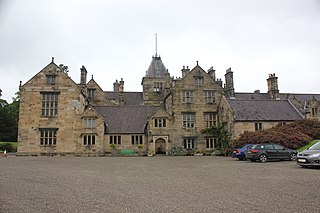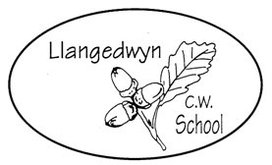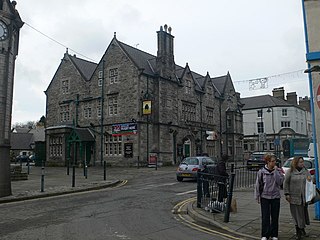
Owain ap Gruffydd, commonly known as Owain Glyndŵr or Glyn Dŵr, was a Welsh leader, soldier and military commander in the Late Middle Ages, who led a 15-year-long revolt with the aim of ending English rule in Wales. He was an educated lawyer, forming the first Welsh parliament under his rule, and was the last native-born Welshman to claim the title Prince of Wales.

Welshpool is a market town and community in Powys, Wales, historically in the county of Montgomeryshire. The town is four miles from the Wales–England border and low-lying on the River Severn; its Welsh language name Y Trallwng means "the marshy or sinking land". The community includes Cloddiau and Pool Quay.

Powis Castle is a medieval castle, fortress and grand country house near Welshpool, in Powys, Wales. The seat of the Herbert family, earls of Powis, the castle is known for its formal gardens and for its interiors, the former having been described as "the most important", and the latter "the most magnificent", in the country. The castle and gardens are under the care of the National Trust. Powis Castle is a Grade I listed building, while its gardens have their own Grade I listing on the Cadw/ICOMOS Register of Parks and Gardens of Special Historic Interest in Wales.

Sycharth was a motte and bailey castle near Llansilin, Powys, Wales. Until 1996 Sycharth was in the historic county of Denbighshire, but was then transferred to the Shire area of Montgomeryshire within Powys. Sycharth was the birthplace of Owain Glyndŵr.

Chwilog is a village in Gwynedd, north Wales, and located on the Llŷn Peninsula. It is in the community of Llanystumdwy, near Criccieth, and in the medieval commote of Eifionydd, named after a 5th-century ruler. It is within the Dwyfor Meirionnydd constituency in the UK Parliament and in the Senedd. The name means 'abounding in beetles' and was perhaps transferred from an earlier name of the river.

Llangwm is a small rural village and former community, now in the community of Llantrisant Fawr, in Monmouthshire, south east Wales. It is located 3 miles (4.8 km) east of Usk, on the B4235 Chepstow to Usk road. The main village is at Llangwm Uchaf, with a smaller and more dispersed settlement about 1 mile (1.6 km) to the north-east at Llangwm Isaf .The other settlement in the community is Llansoy. In 2022 the community was abolished and merged with Llantrisant Fawr.

Llanfair Talhaiarn, abbreviated to Llanfair TH, is a village and community approximately 5 miles (8.0 km) south of Abergele in Conwy county borough, Wales. Until 1974 it was included in Denbighshire. The population was 979 in 2001, increasing to 1,070 at the 2011 census with 44% being Welsh language speakers.

Mostyn Hall is a large house standing in 25 acres of garden near the village of Mostyn, Flintshire, Wales. It is designated by Cadw as a Grade I listed building.
The Vale of Glamorgan has 740 listed buildings of which 4% are Grade I listed, 10% Grade II* listed and remainder Grade II listed.

Llangedywn Church In Wales Primary School is a primary school in the Tanat Valley in Mid Wales on the border with Shropshire. It has served the village of Llangedwyn and the surrounding community in Powys and Shropshire since 1825. It has strong links with, and is situated near, St. Cedwyn's Church in Llangedwyn

Llannefydd is a village and community in Conwy County Borough, in Wales. It is located on the border with Denbighshire, between the Afon Aled and River Elwy, 5.7 miles (9.2 km) north west of Denbigh, 5.8 miles (9.3 km) south west of St Asaph, 6.9 miles (11.1 km) south of Abergele and 15.2 miles (24.5 km) south east of Conwy. In the 2011 census the community parish had a population of 590. The community includes the village of Cefn Berain and part of the hamlet of Bont Newydd.

In the United Kingdom, the term listed building refers to a building or other structure officially designated as being of special architectural, historical, or cultural significance; Grade I structures are those considered to be "buildings of exceptional interest". Listing was begun by a provision in the Town and Country Planning Act 1947. Once listed, strict limitations are imposed on the modifications allowed to a building's structure or fittings. In Wales, the authority for listing under the Planning Act 1990 rests with Cadw.

In the United Kingdom, the term listed building refers to a building or other structure officially designated as being of special architectural, historical, or cultural significance; Grade I structures are those considered to be "buildings of exceptional interest". Listing was begun by a provision in the Town and Country Planning Act 1947. Once listed, strict limitations are imposed on the modifications allowed to a building's structure or fittings. In Wales, the authority for listing under the Planning Act 1990 rests with Cadw.

In the United Kingdom, the term listed building refers to a building or other structure officially designated as being of special architectural, historical, or cultural significance; Grade I structures are those considered to be "buildings of exceptional interest". Listing was begun by a provision in the Town and Country Planning Act 1947. Once listed, strict limitations are imposed on the modifications allowed to a building's structure or fittings. In Wales, the authority for listing under the Planning Act 1990 rests with Cadw.

In the United Kingdom, the term listed building refers to a building or other structure officially designated as being of special architectural, historical, or cultural significance; Grade II* structures are those considered to be "particularly important buildings of more than special interest". Listing was begun by a provision in the Town and Country Planning Act 1947. Once listed, strict limitations are imposed on the modifications allowed to a building's structure or fittings. In Wales, the authority for listing under the Planning Act 1990 rests with Cadw.

In the United Kingdom, the term listed building refers to a building or other structure officially designated as being of special architectural, historical, or cultural significance; Grade II* structures are those considered to be "particularly important buildings of more than special interest". Listing was begun by a provision in the Town and Country Planning Act 1947. Once listed, strict limitations are imposed on the modifications allowed to a building's structure or fittings. In Wales, the authority for listing under the Planning Act 1990 rests with Cadw.

The Bull Hotel is a Grade II-listed building in Llangefni, Anglesey, built during the nineteenth century in a seventeenth-century vernacular style. It replaced an earlier inn built on the same site.

Abercynllaith, also sometimes referred to as Aberkenllith, is a hamlet, between Llangedwyn and Pen-y-bont in northeastern Powys, Wales. It lies to the southwest of Oswestry, Shropshire, along the B4396 road, near the English border.

Iscoyd Park is a three-storey redbrick country house in Wrexham County Borough, Wales. It has a slate roof built in the early 18th century. It was sold in 1737 to William Hanmer. The house and estate was then purchased by Philip Lake Godsal in 1843 and remains in the Godsal family to this day. Iscoyd was designated a Grade II* listed building in 1962 as a well-preserved country house. It supported by a range of 18th- and 19th-century service buildings including a park and gardens, outbuildings, coach house, corn house, kennels, laundry, piggery and stables. The dovecote has a pyramidal slate roof. The house is now run by Philip Langley Godsal and his wife Susie, who took over the house from his father Philip Caulfeild Godsal in 2009 and began a complete refurbishment. This was funded by operating as a wedding and events business but also remains the Godsal family home. Iscoyd Park has won various awards for the restoration of the house and outbuildings, including the Historic Houses Association and Sotheby's Restoration Award, the Hudson's Heritage Award for Best Wedding Venue, Hudson's Heritage Award for Best Accommodation, Wales Gold Award for Best Services Accommodation, Bridebook's Best National Wedding venue.

Llanover House, Llanover, Monmouthshire, Wales, was a country house dating from the mid-19th century. Commissioned by Augusta Waddington, and her husband Benjamin Hall, later Baron Llanover, the house was designed by Thomas Hopper and was largely complete by 1837. Lady Llanover was an early champion of Welsh culture and the house became a centre for its investigation and promotion. In the grounds, the Halls created an extensive park. On the wider Ty Uchaf estate, which Lady Llanover had inherited from her father, the Halls created a model estate village, with housing for their workers, chapels, schools, police and fire services, and temperance public houses, as Lady Llanover was also a champion of abstinence. After Lord Llanover's death in 1867, his widow continued to live at the house until her own death in 1896.



















